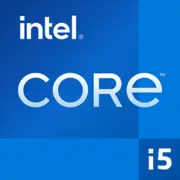Intel Core i5-12500

Intel Core i5-12500: Comprehensive Review of the 2025 Processor
Architecture, Performance, and Relevance in 2025
Key Specifications: Alder Lake in Detail
The Intel Core i5-12500 processor, released in late 2021, remains relevant in 2025, thanks to its balanced architecture and support for modern standards.
Architecture and Process Technology
- Codename: Alder Lake.
- Process Technology: Intel 7 (10 nm Enhanced SuperFin).
- Hybrid Structure: Unlike higher models in the series (e.g., i5-12600K), the i5-12500 uses only 6 Performance-cores (P-cores) without Efficient-cores (E-cores), simplifying thread management.
- Frequencies: Base frequency — 3.0 GHz, maximum turbo frequency — 4.6 GHz.
- Cache: 18 MB L3.
- TDP: 65 W.
Performance
- Geekbench 6: 2285 (Single-Core), 9003 (Multi-Core). These results are close to the Ryzen 5 7600 (2400/9200) but are significantly better than the previous generation (i5-11400: 1800/6500).
- Integrated Graphics: Intel UHD Graphics 770. Supports 4K@60 Hz, AV1 and H.265 encoding. Suitable for less demanding games (e.g., CS:GO on low settings — 60-80 FPS) and office tasks.
Key Features:
- Support for PCIe 5.0 (up to 16 lanes).
- Intel Thread Director technology for workload optimization across cores.
- Hardware protection against vulnerabilities (e.g., Spectre).
Compatible Motherboards
Socket and Chipsets
- Socket: LGA 1700.
- Chipsets: H610 (budget), B660 (optimal), H670, Z690 (premium).
- B660 — the best choice for the i5-12500: supports DDR4/DDR5, PCIe 4.0, USB 3.2 Gen 2x2 (20 Gbps).
- Z690 — excessive, as the processor does not have an unlocked multiplier.
Examples of Boards:
- ASUS TUF Gaming B660-Plus WiFi ($150–170): 2 M.2 slots, Wi-Fi 6.
- Gigabyte H610M S2H ($90–110): minimal features but suitable for basic builds.
Tip: When choosing a board, pay attention to DDR4/DDR5 support as it affects RAM costs.
Memory Support: DDR4 vs DDR5
- DDR4-3200: Budget option. For most tasks (gaming, office work), the difference with DDR5 is minimal.
- DDR5-4800: Provides a 5–15% performance boost in professional applications (rendering, code compilation).
Recommendations:
- For gaming: 16 GB DDR4-3200 (2x8 GB, ~$50).
- For work tasks: 32 GB DDR5-4800 (2x16 GB, ~$130).
Important: Some B660 boards support both types of memory, but not simultaneously — check the specifications.
Power Supply: How to Choose Wisely
- CPU TDP: 65 W, but considering peak loads and other components:
- Without a discrete graphics card: 300–400 W (e.g., be quiet! Pure Power 11 400W, $60).
- With an RTX 4060-level graphics card: 550–650 W (Corsair RM650x, $100).
Tips:
- Opt for power supplies with an 80 Plus Bronze certification or higher.
- Avoid cheap noname models — they may damage components.
Pros and Cons
Pros:
1. Energy Efficiency: Consumes less power than AMD competitors.
2. Integrated Graphics: Allows for building a PC without a discrete graphics card.
3. PCIe 5.0: Support for future NVMe drives.
Cons:
1. No Overclocking: Multiplier is locked.
2. DDR5 Pricing: In 2025, DDR5 modules are still 30–40% more expensive than DDR4.
3. Competition with AMD: Ryzen 5 7600 ($220) is faster in multi-threaded tasks.
Use Cases
Gaming
- Paired with the RTX 4060 Ti: 1080p@144 Hz in Cyberpunk 2077 (high settings, DLSS).
- For emulation (e.g., Yuzu), high single-core performance is essential.
Work Tasks
- Video editing in DaVinci Resolve: 1080p rendering takes 15–20 minutes (versus 25 minutes on i5-11400).
- Programming: Quick code compilation in Visual Studio.
Multimedia
- Streaming through OBS using Quick Sync.
- Supports Dolby Vision for HDR content.
Comparison with Competitors
1. AMD Ryzen 5 7600 ($220):
- Pros: +10% in multi-threading, supports PCIe 5.0.
- Cons: Requires expensive AM5 motherboards ($120+).
2. Intel Core i5-12400F ($150):
- Pros: Cheaper, similar performance.
- Cons: Lacks integrated graphics.
Conclusion: The i5-12500 is a great option if you need an iGPU or PCIe 5.0 support.
Practical Assembly Tips
1. Cooling: The stock cooler is sufficient, but for quieter operation, choose a tower cooler (DeepCool AK400, $35).
2. Storage: Use NVMe SSDs with PCIe 4.0 (Samsung 980 Pro 1TB, $90).
3. Case: Ensure proper airflow (e.g., NZXT H510 Flow, $80).
Final Conclusion: Who Should Consider the i5-12500?
This processor is an ideal choice for:
- Gamers with a budget of up to $1000: a good balance of price and performance.
- Office users: Reliability and integrated graphics.
- Content creators: Fast rendering and DDR5 support.
Alternatives:
- If overclocking is needed — i5-12600K.
- For maximum multi-threading — Ryzen 5 7600.
In 2025, the i5-12500 remains a cost-effective option for those not chasing top-tier performance but valuing stability and technological advancement.
Basic
CPU Specifications
Memory Specifications
GPU Specifications
Miscellaneous
Benchmarks
Compared to Other CPU
Share in social media
Or Link To Us
<a href="https://cputronic.com/cpu/intel-core-i5-12500" target="_blank">Intel Core i5-12500</a>